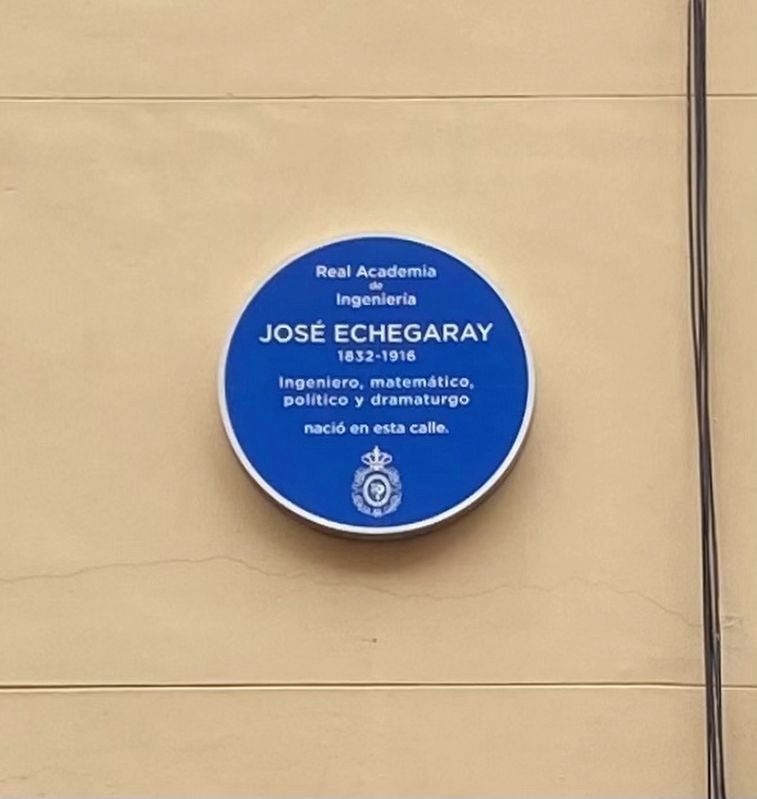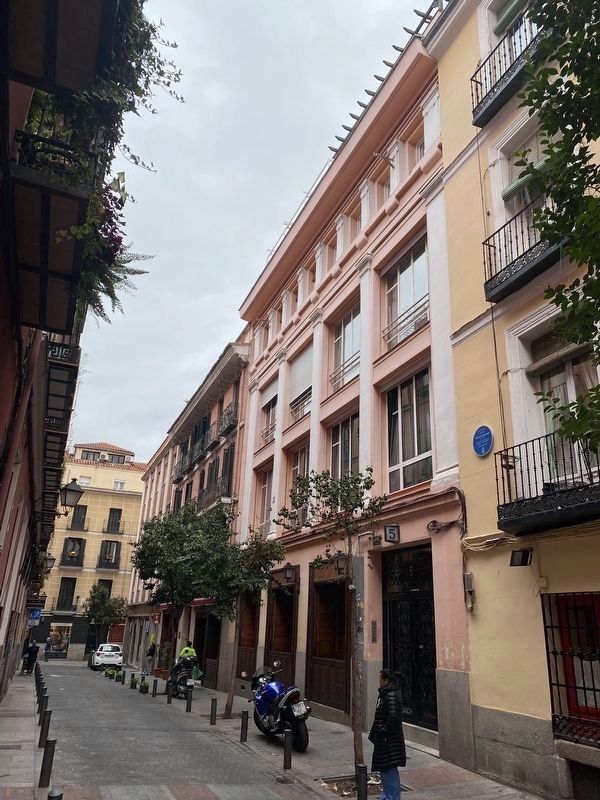Cortes in Madrid, Spain — Southwestern Europe (Iberian Peninsula)
José Echegaray
José Echegaray
1832-1916
Ingeniero, matemático,
politico y dramaturgo
nació en esta calle.
(English translation:)
José Echegaray (1832-1916), engineer, mathematician, politician and playwright was born on this street.
Erected by Real Academia de Ingenieria.
Topics. This historical marker is listed in these topic lists: Arts, Letters, Music • Government & Politics • Science & Medicine. A significant historical date for this entry is April 19, 1832.
Location. 40° 24.837′ N, 3° 41.86′ W. Marker is in Madrid. It is in Cortes. Marker is on Calle de Quevedo, on the right when traveling north. Touch for map. Marker is at or near this postal address: Calle de Quevedo 5, Madrid 28014, Spain. Touch for directions.
Other nearby markers. At least 8 other markers are within walking distance of this marker. Miguel Cervantes Saavedra (within shouting distance of this marker); Lope de Vega (within shouting distance of this marker); Elena Fortún (within shouting distance of this marker); Francisco de Quevedo y Villegas (within shouting distance of this marker); Ricardo Becerro de Bengoa (within shouting distance of this marker); Emilia Pardo Bazán (La Coruña 1851 - Madrid 1921) (within shouting distance of this marker); Sor Marcela de San Félix (within shouting distance of this marker); Miguel de Cervantes (about 90 meters away, measured in a direct line). Touch for a list and map of all markers in Madrid.
Also see . . .
1. José Echegaray (Wikipedia).
Excerpt: José Echegaray y Eizaguirre (19 April 1832 – 14 September 1916) was a Spanish civil engineer, mathematician, statesman, and one of the leading Spanish dramatists of the last quarter of the 19th century. He was awarded the 1904 Nobel Prize in Literature "in recognition of the numerous and brilliant compositions which, in an individual and original manner, have revived the great traditions of the Spanish drama".(Submitted on December 4, 2022.)
2. José Echegaray (The Nobel Prize). “This autobiography/biography was written at the time of the award and first published in the book series Les Prix Nobel. It was later edited and republished in Nobel Lectures.”
Excerpt: José de Echegaray (1833-1916), son of a professor of Greek, was born in Madrid. He went to an engineering school, studied economics, and had a distinguished career in the Spanish Government. He was successively Minister of Public Works and Finance Minister. At the height of his career he turned to the stage, a passion that dated back to his youth. A mathematician, engineer, and administrator, he built his plays with the same regard for exactitude and duty that inspired his public life. Conflicts involving duty are at the heart of most of his plays, and he upheld the idea with uncompromising severity. His exalted romanticism appears in his choice of subjects. Like his great predecessors of the Spanish Golden Age, Echegaray was a prolific playwright. His most famous plays were: La esposa del vengador 1874) [The Avenger’s Wife]; En el puño de la espada (1875) [The Sword’s Handle]; En el pilar y en la cruz (1878) [The Stake and the Cross], a play defending the freedom of thought, which aroused much controversy; Conflicto entre dos deberes 1882) [Conflict of Duties], the title of which is programmatic for Echegaray’s entire work; O locura ó santidad 1877) [Madman or Saint]; and El gran Galeoto1881) [Great Galeoto ].(Submitted on December 4, 2022.)
Additional keywords. Nobel
Credits. This page was last revised on February 2, 2023. It was originally submitted on December 4, 2022, by Andrew Ruppenstein of Lamorinda, California. This page has been viewed 67 times since then and 12 times this year. Photos: 1, 2. submitted on December 4, 2022, by Andrew Ruppenstein of Lamorinda, California.

